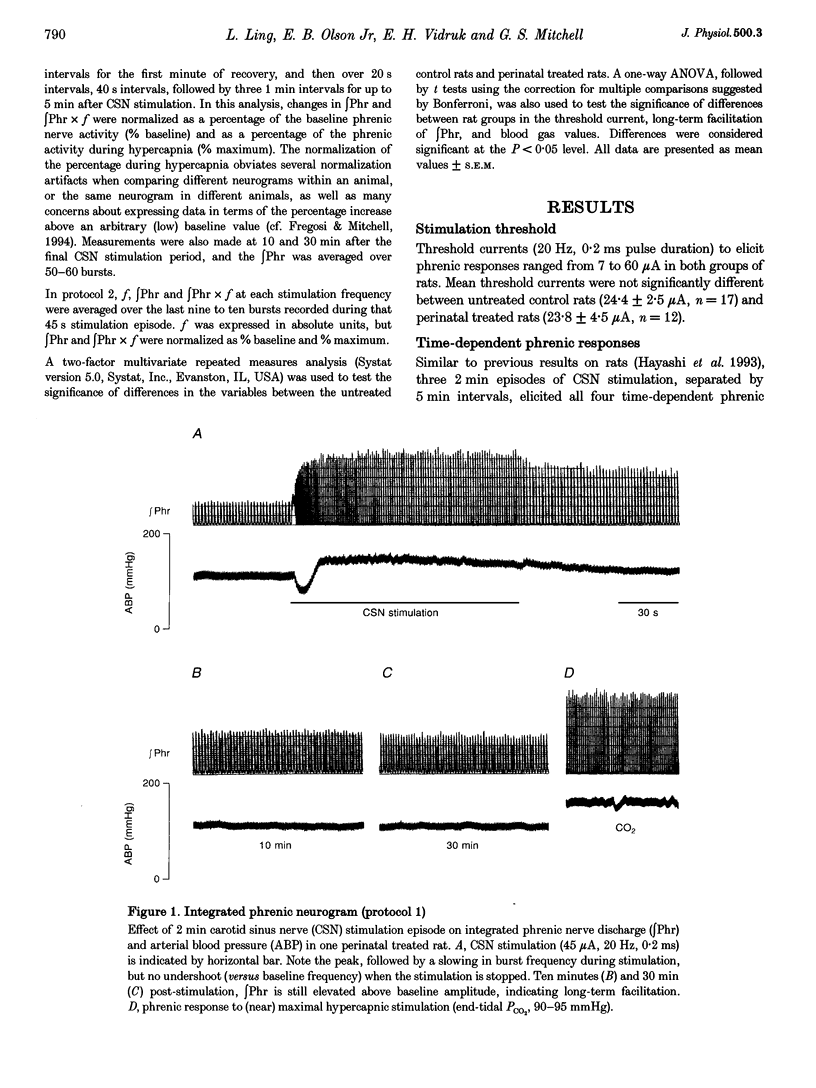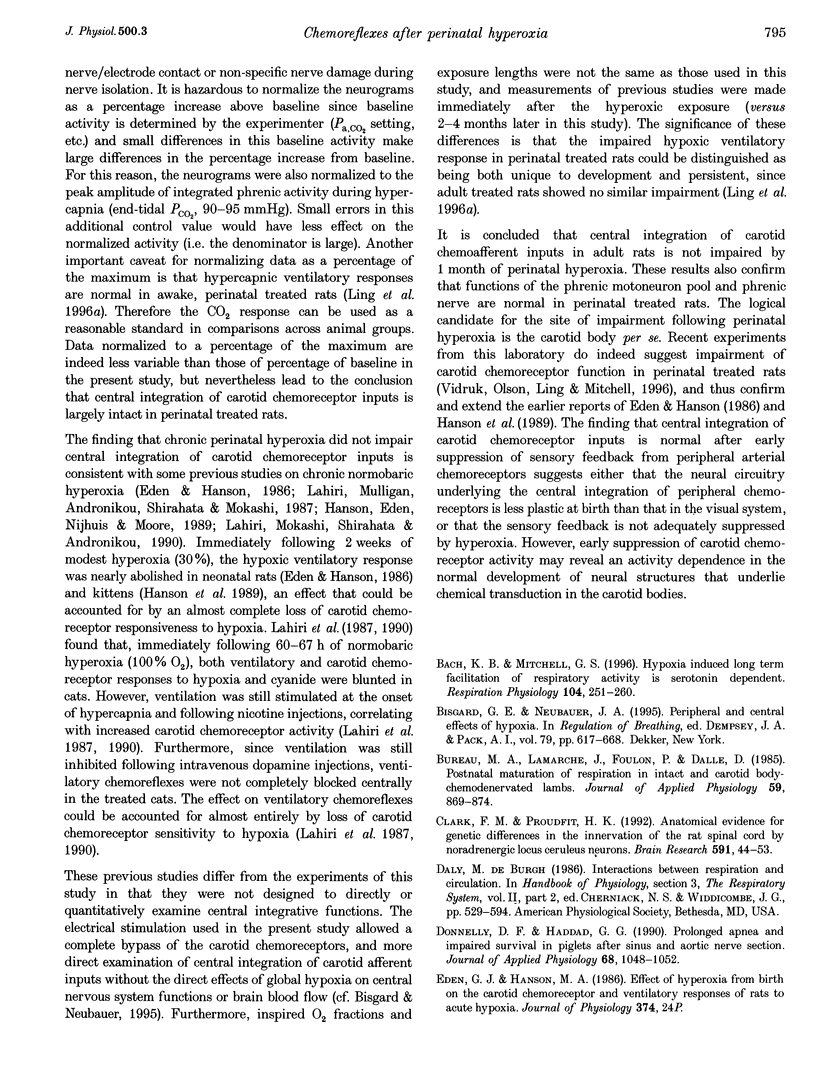Abstract
1. Hypoxic ventilatory responses are greatly attenuated in adult rats exposed to moderate hyperoxia (60% O2) during the first month of life (perinatal treated rats). The present study was designed to test the hypothesis that perinatal hyperoxia impairs central integration of carotid chemoreceptor afferent inputs, thereby diminishing the hypoxic ventilatory response. 2. Time-dependent phrenic nerve responses to electrical stimulation of the carotid sinus nerve (CSN) and steady-state relationships between CSN stimulation frequency and phrenic nerve output were compared in control and perinatal treated rats. The rats were urethane anaesthetized, vagotomized, paralysed and artificially ventilated. End-tidal CO2 was monitored and maintained at isocapnic levels; arterial blood gases were determined. 3. Two stimulation protocols were used: (1) three 2 min episodes of CSN stimulation (20 Hz, 0.2 ms duration, 3 x threshold), separated by 5 min intervals; and (2) nine 45 s episodes of CSN stimulation with stimulus frequencies ranging from 0.5 to 20 Hz (0.2 ms duration, 3 x threshold), separated by 4 min intervals. 4. The mean threshold currents to elicit phrenic responses were similar between groups. Burst frequency (f, burst min-1), peak amplitude of integrated phrenic activity (integral of Phr), and minute phrenic activity (integral of Phr x f) during and after CSN stimulation were not distinguishable between groups in either protocol at any time or at any stimulus intensity (P > 0.05). 5. Perinatal hyperoxia does not alter temporal or steady-state phrenic responses to CSN stimulation, suggesting that the central integration of carotid chemoreceptor afferent inputs is not impaired in perinatal treated rats. It is speculated that carotid chemoreceptors per se are impaired in perinatal treated rats.
Full text
PDF









Selected References
These references are in PubMed. This may not be the complete list of references from this article.
- Bach K. B., Mitchell G. S. Hypoxia-induced long-term facilitation of respiratory activity is serotonin dependent. Respir Physiol. 1996 Jul;104(2-3):251–260. doi: 10.1016/0034-5687(96)00017-5. [DOI] [PubMed] [Google Scholar]
- Bureau M. A., Lamarche J., Foulon P., Dalle D. Postnatal maturation of respiration in intact and carotid body-chemodenervated lambs. J Appl Physiol (1985) 1985 Sep;59(3):869–874. doi: 10.1152/jappl.1985.59.3.869. [DOI] [PubMed] [Google Scholar]
- Clark F. M., Proudfit H. K. Anatomical evidence for genetic differences in the innervation of the rat spinal cord by noradrenergic locus coeruleus neurons. Brain Res. 1992 Sep 18;591(1):44–53. doi: 10.1016/0006-8993(92)90976-g. [DOI] [PubMed] [Google Scholar]
- Donnelly D. F., Haddad G. G. Prolonged apnea and impaired survival in piglets after sinus and aortic nerve section. J Appl Physiol (1985) 1990 Mar;68(3):1048–1052. doi: 10.1152/jappl.1990.68.3.1048. [DOI] [PubMed] [Google Scholar]
- Fregosi R. F., Mitchell G. S. Long-term facilitation of inspiratory intercostal nerve activity following carotid sinus nerve stimulation in cats. J Physiol. 1994 Jun 15;477(Pt 3):469–479. doi: 10.1113/jphysiol.1994.sp020208. [DOI] [PMC free article] [PubMed] [Google Scholar]
- Hayashi F., Coles S. K., Bach K. B., Mitchell G. S., McCrimmon D. R. Time-dependent phrenic nerve responses to carotid afferent activation: intact vs. decerebellate rats. Am J Physiol. 1993 Oct;265(4 Pt 2):R811–R819. doi: 10.1152/ajpregu.1993.265.4.R811. [DOI] [PubMed] [Google Scholar]
- Hofer M. A. Role of carotid sinus and aortic nerves in respiratory control of infant rats. Am J Physiol. 1986 Oct;251(4 Pt 2):R811–R817. doi: 10.1152/ajpregu.1986.251.4.R811. [DOI] [PubMed] [Google Scholar]
- Lahiri S., Mokashi A., Shirahata M., Andronikou S. Chemical respiratory control in chronically hyperoxic cats. Respir Physiol. 1990 Nov;82(2):201–215. doi: 10.1016/0034-5687(90)90035-w. [DOI] [PubMed] [Google Scholar]
- Lahiri S., Mulligan E., Andronikou S., Shirahata M., Mokashi A. Carotid body chemosensory function in prolonged normobaric hyperoxia in the cat. J Appl Physiol (1985) 1987 May;62(5):1924–1931. doi: 10.1152/jappl.1987.62.5.1924. [DOI] [PubMed] [Google Scholar]
- Ling L., Olson E. B., Jr, Vidruk E. H., Mitchell G. S. Attenuation of the hypoxic ventilatory response in adult rats following one month of perinatal hyperoxia. J Physiol. 1996 Sep 1;495(Pt 2):561–571. doi: 10.1113/jphysiol.1996.sp021616. [DOI] [PMC free article] [PubMed] [Google Scholar]
- Millhorn D. E., Eldridge F. L., Waldrop T. G. Prolonged stimulation of respiration by a new central neural mechanism. Respir Physiol. 1980 Jul;41(1):87–103. doi: 10.1016/0034-5687(80)90025-0. [DOI] [PubMed] [Google Scholar]
- Millhorn D. E., Eldridge F. L., Waldrop T. G. Prolonged stimulation of respiration by endogenous central serotonin. Respir Physiol. 1980 Dec;42(3):171–188. doi: 10.1016/0034-5687(80)90113-9. [DOI] [PubMed] [Google Scholar]
- Wiesel T. N. Postnatal development of the visual cortex and the influence of environment. Nature. 1982 Oct 14;299(5884):583–591. doi: 10.1038/299583a0. [DOI] [PubMed] [Google Scholar]


